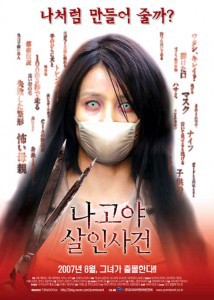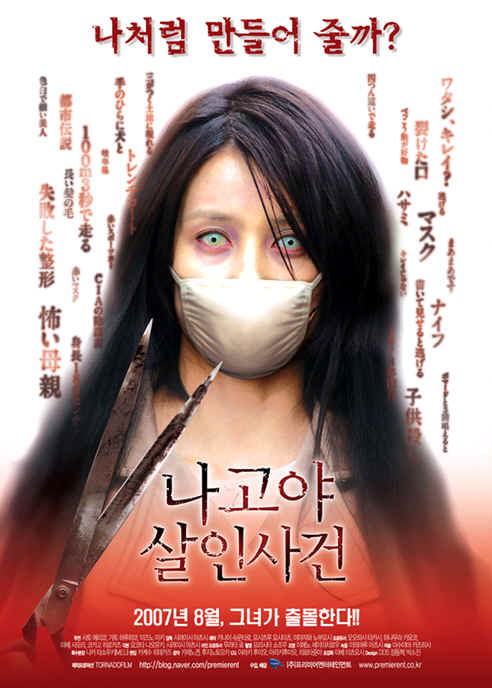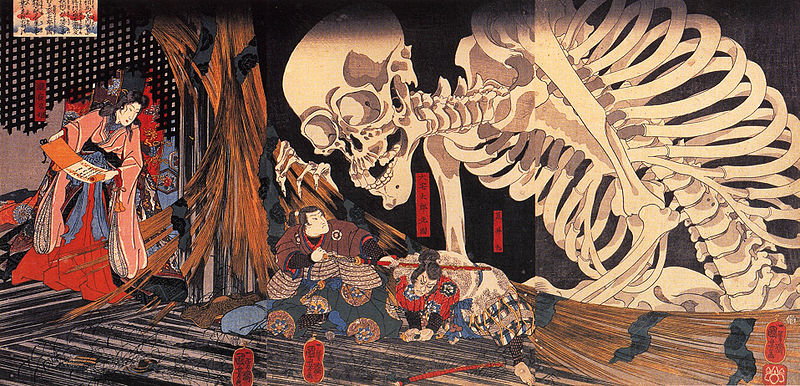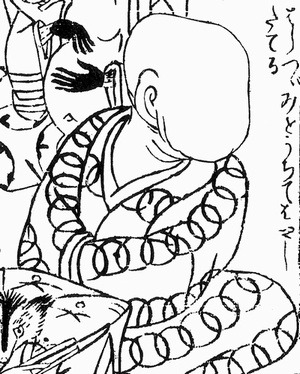
A recurring theme on this blog is that Japan is a land haunted by all sorts of weird ghosts and goblins. From gigantic blood sucking skeletons to flying heads in flaming ox-cart wheels, Japan’s rogues gallery is one of the most unique in the world.
Even its more plausible boogeymen have an eerie quality to them. Take, for example, the kuchisake-onna, better known as the Slit-Mouthed Woman (also the name of a J-horror movie I reviewed four years ago, based on the legend.) She is said to be a beautiful woman dressed in a long coat, with a surgical mask covering her face. Surgical masks are commonly worn in Japan and other East Asian countries when a person is suffering from a cold or flu. In the case of the Slit-Mouthed Woman, the mask is covering something far more horrifying than a mere cold sore–her cheeks have been slashed open, literally making her smile go “ear to ear.” In some accounts she is said to have as many as 130 teeth–fangs really–giving an even more eerie cast to her horrible deformity. Even more extraordinary, some variants of her story have the Slit-Mouthed Woman able to run like an Olympian, covering 100 yards in as little as 3 seconds. She carries a pair of scissors or a scythe, which she uses to slash her victim’s cheeks to make them look like she does.
A 20th Century Monster
Perhaps the variance in her description comes from the fact that there is little agreement on her origins. Her story began circulating among Japanese school children in 1978, during which time a variety of stories attributed to her began to circulate. Some say that she is a vengeful ghost mutilated in the feudal era by her jealous samurai husband who caught her cheating on him. Others claim she is no ghost at all, but rather a woman (perhaps an Olympic athlete given her fleet feet) who was horrifically disfigured in a botched dental procedure. This could explain her fondness for medical paraphernalia, such as scissors and gauze masks. Another version has the Slit-Mouthed Woman being attacked by her jealous sister, who slashed her cheeks with a pair of scissors.
Whatever the case, encounters with this yokai/mad woman are said to occur in broad daylight, in the afternoon when many children are walking home from school. She approaches her potential victims and asks them “Do I look beautiful?” If the hapless victim answers in the affirmative, she rips off the mask revealing her toothy grin and says, “Even like this?’ before lashing out with her blade. Answer no, and she attacks anyway.
One key to surviving an encounter with the Slit-Mouthed Woman intact is distraction. After all, she is either an Olympic level athlete (who apparently remains swift on her feet even well into middle age) or a being possessing supernatural speed–running is not an option, unless of course you’d like to be disfigured and winded at the same time. When she asks her question, the best answer is an ambivalent one–say “so-so” or “average.” She will be confused, and in that time you can make good your escape.
Two more things that can distract the Slit-Mouthed Woman are Bekko ame, a traditional Japanese candy, and hair pomade. She reportedly loves candy, and will break off an attack if you throw Bekko ame at her. She is repulsed by the scent of hair pomade, supposedly because the doctor who disfigured her in some versions of the legend stunk of the stuff. Even saying the word “pomade” three to six times can be enough to scare her off.
A result of collective delusion?
These elements, mixing the potentially plausible with the clearly folkloric, make the Slit-Mouthed Woman unique among Japan, and the world’s, vast cast of nightmarish creatures. She exists in a sort of netherworld, not quite a ghost yet not quite a real person either. Perhaps that is why, more than 30 years after stories about her first began to circulate, she still remains a popular legend, one that almost all Japanese school children have heard at one point. Her ambiguous nature leaves room for all sorts of elaboration for school-yard storytellers, giving fertile ground for the legend to grow and evolve with succeeding generations of school children.
Many explanations of the legend’s origins have been presented. Some believe that the Slit-Mouthed Woman was a sort of phantom-slasher, a being born of the remarkable pressures Japanese school children face within Japan’s famously tough school system. This then would be a case of collective delusion, a phenomena often confused with mass hysteria. Collective delusions are characterized by the rapid spread of an irrational belief among a community that results in irrational behavior but not necessarily physical symptoms, while mass hysteria is a form of mass conversion disorder, where societal pressures and personal anxiety are vented by conversion into physical symptoms.
I covered an example of collective delusion on my own blog, which seems relevant to this case due to the similarity of the age groups involved. In Glasgow, Scotland, an irrational belief that an iron-toothed vampire responsible for killing at least two children lurked in the local cemetery took hold in school age children, prompting many to take up stakes and turn amateur vampire hunter. The weird happening grew out of playground stories that took on a life of their own. Perhaps the same dynamic is at work with the Slit-Mouthed Woman, although it is unusual for a collective delusion to have such a long life and the appearance of the Slit-Mouthed Woman in 1978 does not appear to have caused a panic similar to the one that gripped Glasgow in the 1950s.
There is another possibility. The Slit-Mouthed Woman story is technically classified as an urban legend. While urban legends are modern folklore, they differ in that their central conceit is either based on true events or are at least plausible. Could the Slit-Mouthed Woman legend be based on a real incident that occurred in 1978, or not long before?
Such a notion sounds far fetched, but there is precedent for such an occurrence. The Bunnyman Bridge in Maryland is routinely listed as one of the scariest places on Earth. The Bunnyman, a supernatural bogey with a bunny suit and a penchant for mayhem, is said to haunt the bridge tunnel, where legend has it that he has slaughtered dozens of teens foolhardy enough to venture there on Halloween night. While the elaborate and seemingly plausible origin story of the Bunnyman, which I won’t go into here but you can read about in depth on my blog, is bunk, there is an odd element of truth to the story. A mysterious figure in a bunny suit who wielded an axe did appear in the area around the infamous bridge in the 1970s. While he didn’t kill anyone, his odd behavior and aggressive acts cemented his image in the local unconscious, eventually resulting in the Bunnyman legend told and retold today.
Maybe a similar dynamic is at work with the Slit-Mouthed Woman legend. Perhaps a woman wearing a surgical mask did go on a rampage in the 1970s. Or perhaps the story has more mundane origins, in children’s fear of the unknown. Whatever the case, the legend of the Slit-Mouthed Woman is a part of Japan’s folklore, and it is here to stay.
Sources:
Fitch, Laura. “Have you heard the one about…?” japantimes.co.jp. June 7, 2005. The Japan Times. April 18, 2015. http://www.japantimes.co.jp/community/2005/06/07/community/have-you-heard-the-one-about/#.VTPwCpN9mWN
“Kuchisake Onna.” Scaryforkids.com. August 21, 2014. Retrieved April 18, 2015. http://www.scaryforkids.com/kuchisake-onna/
“Kuchisake-onna.” urbanlegendsonline.com. September 13, 2011. Urban Legends Online. April 18, 2015. http://urbanlegendsonline.com/kuchisake-onna/
Yodo, Hiroko and Alt, Matt. “Yokai Attack! The Japanese Monster Survival Guide.” Tuttle Publishing. 2008.



